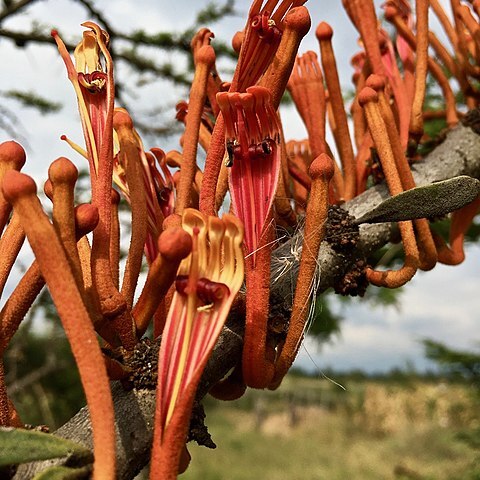Corolla 5(exceptionally 6)-lobed, with tube longer than lobes, usually yellow or orange with red markings or more generally reddish, but colours often muted by indumentum; apical swelling of bud fusiform to globular, sometimes ribbed or narrowly winged; basal swelling variably developed; tube split unilaterally, the V-slit extending little more or less than halfway, papillate along sutures and edges of filament lines to varying degrees; lobes erect or reflexed, narrow below, upper part expanded to varying degrees and often hardened inside.
Stamen filaments attached near base of lobes, linear, inrolled at anthesis, sometimes with a tooth in front of the anther; anther oblong to linear-oblong, with 4 thecae transversely divided into several to many locules.
Shrubs, often large and pendent, with a single haustorial attachment; branchlets slightly compressed; youngest parts, at least, always with scales, stellate and verticillately branched dendritic hairs.
Style slender, 5-angled or narrowly 5-winged, often expanded opposite filaments and narrowed opposite anthers, sometimes papillate or hairy; stigma globular to obovoid or conical-ovoid.
Flowers in sessile to shortly pedunculate umbels or 2–several in the axils; bract unilateral, often gibbous, sometimes enlarged and foliaceous.
Leaves opposite, subopposite or rarely ternate, generally petiolate, usually somewhat coriaceous, penninerved.
Berry reddish or often blue to blue-green, ellipsoid or obovoid, generally with persistent calyx.
Calyx annular to shortly tubular, generally shorter than receptacle, subentire to shortly lobed.
